| |||||||||||||||||||||
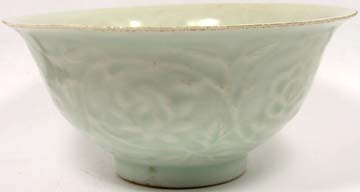
Nicely Preserved, Large Genuine 12th to 15th Century Song/Ming Dynasty Chinese “Celadon Green” Glazed Floral Motif Carved Porcelain Bowl.
CLASSIFICATION: “Carved” Floral Motif “Celadon Green” Glazed Porcelain Bowl.
ATTRIBUTION: In the Style of Ancient China, Song Dynasty (906-1279 A.D.). Possibly an Early Ming or even an 18th or 19th Century Revival Imitative.
SIZE/MEASUREMENTS:
Height: 59 millimeters (2 3/8 inches).
Diameter: 128 millimeters (5 1/8 inches) at top lip; 49 millimeters (2 inches) at the base.
CONDITION: Very good. A little wear, the typical blemishes of hand production (warts and dimples, zits and pits). Not flawless, but certainly in a remarkable state of preservation. A quite collectable carved, celadon green Song bowl.
DETAIL: A nicely preserved traditional glazed, carved porcelain bowl so wonderfully characteristic of late Song/Early Ming Dynasty artwork. This style became known as “Celadon Green” – so named for the color – and is one of the most celebrated styles of ancient China. You can see that the “highlight” or focal point to this piece is extensive and intricate carved design present on the bowl, the design hand carved before the piece was glazed and fired. The intricate and fine raised lines you see were created not by the application of additional material, but by carving away the relief areas, leaving intact what became perceived as raised, spidery floral embellishments. The glaze is almost entirely intact, though if you inspect the piece very closely, you can observe that the finish shows very slight crazing, quite characteristic of antique and ancient glazed porcelain.

There are as well, of course, a few minor scuffs, marks, dings, etc. All of the tiny little blemishes which are almost obligatory for such a bowl. And there are some dirt adhesions to the unglazed underside of the pedestal, indicating of course that the vase was buried for some period of time. Of course realistically one would expect some blemishes, so there are no real surprises here except that there are so few blemishes. The glazing is almost entirely intact, the “celadon green” quite vibrant and intense. There are a few production blemishes, again really not noticeable, just the warts, dimples, zits, and pits quite typical of hand-crafted ceramics of Song and Ming Dynasty period porcelain. All of the preceding almost entirely expected and exceedingly – we’re just playing critic here in the interest of full disclosure. This is about as good as one can reasonably expect of an authentic antique/ancient bowl such as this, unless you are willing to enter the rarified atmosphere (and price tags) of museum quality (flawless) porcelain pieces.
Although it is probable that this specimen is much older, it would be remiss of us not to mention the fact that it is also possible that this piece might be a revivalist imitative produced for the European market of the 18th or 19th century. It is widely known that Chinese porcelain and other ceramic artwork was quite popular in Victorian Europe. Carrying Chinese porcelain from China to Europe was an industry for the seafaring mariners of the 16th, 17th, and 18th centuries. Entire fleets of sailing ships plied the trade, especially the Dutch and English. However in addition to porcelain, ancient Chinese ceramics were also extremely popular in Victorian Europe, where Chinese ceramic artwork was highly appreciated and in great demand.
Although the style of this specimen is very convincing and suggests it might indeed be of late Song or early Ming Dynasty origin (12th to 15th century), a large portion of the antique/ancient Chinese ceramics in Europe date to the 18th or 19th century, so it is quite possible that this is an imitative revival piece. Judging by the style it is likely considerably older, but only a $800 thermoluminescence test would establish this conclusively (and even then the reliability and accuracy of such testing is still debated). So we’ll simply err on the side of being conservative and suggest that you consider it a revival piece, and if it is indeed older, so much the better. However whether an antique several centuries old, or an antiquity a few centuries older, this is a valuable and collectible piece of art.

It’s not perfect, but it is an exceptionally attractive piece, and extraordinarily well preserved specimen of the ancient Chinese art of pottery. If you’d like an authentic ancient celadon green Song bowl to proudly display, you could not go wrong with this one. It is solidly shaped, nicely featured, and perfectly proportioned. You could display this one with great pride either at work on your desk or at home in the kitchen or dining room. Whether at home or at work, for use as a bowl for candies or simply to display on its own merits, it will certainly generate curiosity and more than a little envy!
HISTORY OF SONG EARTHENWARE: Fifty years of chaos followed the fall of the Tang Dynasty before the rise of two competing but complementary Dynasties in China; the shorter-lived Liao to the North and the Song to the South. Liao ceramics are unique in form, glaze and design but still utilize Chinese techniques, sometimes showing Tang influence. Liao ceramics are often monochrome white and black similar to that which would be widely produced in the future during the Yuan dynasty. Other Liao ceramics are similar to Tang sancai (three color) lead glazes. The most fundamentally unique characteristics of Laio ceramics were their shapes. To the South, the arts of the Song Dynasty showed introspection and refinement. The Song emperors were among China's most culturally enlightened rulers, many were accomplished artists in their own right. Song ceramics provide a parallel to the era’s renowned landscape painting in their variety and accomplishments.
The finest ceramic products included Ting ware characterized by a milky white glaze and delicately carved or impressed designs. A common motif featured lotus blossoms, which were originally a Buddhist symbol but were often used for decoration in Song secular art. Also highly regarded is vividly colored Chün ware, with splashes of red or purple painted on a blue glazed surface. It was popular in the royal court and was often used for bowls and flowerpots. Classic blue-green celadon and white porcelain continued to be produced in large quantities, most frequently found in the shape of vases. In addition to these royal favorites, a group of popular stoneware, called Tz'u-chou, was manufactured in for local use. The Tz'u-chou potters used a wide variety of decorative techniques, including glazing, painting, incising, and enameling. Chien ware was the favorite of Buddhist monks in Fujian Province who drank their tea from glossy, black-glazed bowls.
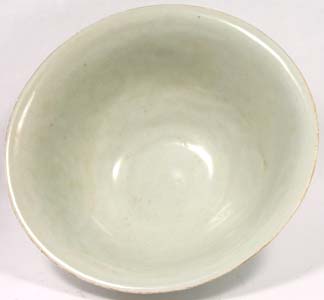
During the Song Dynasty porcelain kilns were established at Jingdezhen, where porcelain is still produced today. Jingdezhen became the dominant producer due to its proximity to deposits of high-quality porcelain clay and to two major river systems for transport. Their kilns were particularly successful due to the innovation we know as assembly line techniques. Huge demand came both from a growing Chinese middle class and from foreign merchants, and led to a diversity of shapes, glazes, and decorative motifs. The Song dynasty was the most important dynasty in Chinese porcelain history, and brought prosperity in porcelain production. Amongst the most famous porcelain every produced were exceedingly fine and delicate Ru Kiln wares which used special a glaze with orange carnelian added. The production of Ru ware lasted only 20 years, and today are so rare that only about 70 pieces are known to still exist.
HISTORY OF THE SONG DYNASTY: The collapse of the Tang Dynasty in 907 A.D. formed the backdrop for the rise the Sung and Liao Dynasties. During the fifty years following the collapse China fragmented into ten different kingdoms, constantly in conflict with one another, and a rapid succession of five dynasties formed and then collapsed. The Five Dynasties period ended in 960 A.D. when a military leader seized the throne and proclaimed the establishment of the Sung (Song) Dynasty (960-1279 A.D.) and reunified most of China. However the Mongols who were responsible for the demise of the preceding Tang Dynasty formed their own kingdom in North China known as the Liao Dynasty (907-1125 A.D.).
For the only time in China, the contemporaneous monarchs of both the Liao and Song Dynasties recognized one another as possessing “the mandate of heaven” to rule China as the “son of heaven” – a situation similar to that of Ancient Egypt whereby one Dynasty ruled Upper Egypt, the other Lower Egypt, both Pharaohs recognizing one another’s divine right to rule. Notwithstanding the shorter-lived Northern Liao Dynasty, the Song Dynasty proved to be the longer lived, and controlled most of China. The founders of the Song Dynasty built an effective centralized bureaucracy staffed with civilian scholar-officials. Notable for the development of cities not only as administrative entities, but also as centers of trade, industry, and maritime commerce, the Sung Dynasty gave rise to a new group of wealthy commoners, the mercantile class. Printing and education spread, private trade grew, and a market economy began to link the coastal provinces and the interior. Landholding and government employment were no longer the only means of gaining wealth and prestige.
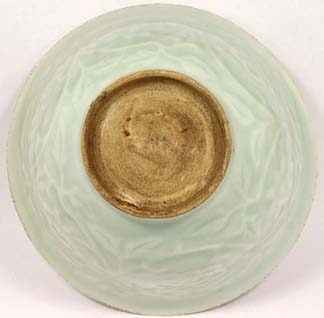
Unfortunately fearing a repeat of the anarchy created in the Tang Dynasty by petty military rulers in the frontier areas, the Sung Monarchs severely limited the power and authority of provincial military commanders. They were subordinate to centrally appointed civilian officials who had replaced the regional military governors of the Tang. Though this gave greater power and control to the emperor and his palace bureaucracy, it also led a chronic problem with military weakness. Weakness which proved to be fatal to the Sung Dynasty as they confronted the Mongols under the leadership of Kublai Khan, grandson of Genghis Khan.
HISTORY OF CHINESE EARTHENWARE: The first Chinese ceramics archaeologists have found date back more than 10,000 years. These were earthenware, which means they were made from clay and fired at the kind of low temperatures reached by a wood fire or simple oven. In China, most ceramics made before the Tang dynasty (600 A.D.) are earthenware. They may be glazed or unglazed, and are occasionally painted, often brightly colored. Stoneware ceramics are harder and less porous than earthenware and are fired at hotter temperatures—between 2100°F and 2400°F. At these high temperatures, the surface of the clay melts and becomes glassy. Although stoneware is usually waterproof, most stoneware ceramics are glazed for decoration. The glazes often contain ash, which allows the glaze to harden at stoneware temperatures.
During the Shang Dynasty (1600-1100 B.C.) bronze metallurgy superceded ceramics as the favored art form of the ruling class. However both the ceramic and the bronze industries evolved into complex systems of production that were supported by the aristocracy. Decorative designs rich in symbolism were created first in bronze were then imitated in clay. Chinese burial customs included the tradition of placing clay replicas of material possessions, animals and people in the tomb to accompany the deceased and serve them in the next life. Although archaeological finds have revealed that glazed pottery was produced as early as 1100 B.C. during the Zhou dynasty, the production of glazed wares was not common until about 200 B.C. during the Han Dynasty. However from about 1000 B.C. onwards during the Shang and Zhou dynasties, primitive porcelain wares emerged. Real porcelain wares appeared in the Han dynasty around 200 A.D. In the process of porcelain development, different styles in different periods blossomed.
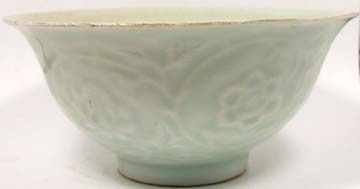
The production of porcelain became widespread by about 500 A.D. Using a special clay with ground rock containing feldspar, a glassy mineral, the material was fired at very high temperatures above 2400°F. The surface of the clay melts at such high temperatures and becomes smooth as glass. Early porcelains were undecorated and were used by the Imperial court and exported as far as the Middle East. For instance during the Han Dynasty principally celadon (green) and black porcelain were mainly produced. The famous blue and white porcelain was created with blue paint made from cobalt and then covered with a clear glaze, which can withstand the high temperatures of the kiln. The technical and creative innovations of Chinese potters are unique accomplishments in the cultural heritage of the world. Today, archaeological excavation and research in China are revealing new sites and new examples of the genius of the Chinese potter.
HISTORY OF CHINESE CIVILIZATION: Remains of Homo erectus, found near Beijing, have been dated back 460,000 years. Recent archaeological studies in the Yangtse River area have provided evidence of ancient cultures (and rice cultivation) flourishing more than 11,500 years ago, contrary to the conventional belief that the Yellow River area was the cradle of the Chinese civilization. The Neolithic period flourished with a multiplicity of cultures in different regions dating back to around 5000 B.C. There is strong evidence of two so-called pottery cultures, the Yang-shao culture (3950-1700 B.C.) and the Lung-shan culture (2000-1850 B.C). Written records go back more than 3,500 years, and the written history is (as is the case with Ancient Egypt) divided into dynasties, families of kings or emperors. The voluminous records kept by the ancient Chinese provide us with knowledge into their strong sense of their real and mythological origins – as well as of their neighbors.
By about 2500 B.C. the Chinese knew how to cultivate and weave silk and were trading the luxurious fabric with other nations by about 1000 B.C. The production and value of silk tell much about the advanced state of early Chinese civilization. Cultivation of silkworms required mulberry tree orchards, temperature controls and periodic feedings around the clock. More than 2,000 silkworms were required to produce one pound of silk. The Chinese also mastered spinning, dyeing and weaving silk threads into fabric. Bodies were buried with food containers and other possessions, presumably to assist the smooth passage of the dead to the next world. The relative success of ancient China can be attributed to the superiority of their ideographic written language, their technology, and their political institutions; the refinement of their artistic and intellectual creativity; and the sheer weight of their numbers.
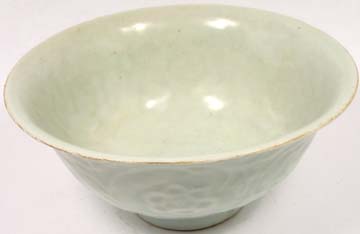
A recurrent historical theme has been the unceasing struggle of the sedentary Chinese against the threats posed by non-Chinese peoples on the margins of their territory in the north, northeast, and northwest. China saw itself surrounded on all sides by so-called barbarian peoples whose cultures were demonstrably inferior by Chinese standards. This China-centered ("sinocentric") view of the world was still undisturbed in the nineteenth century, at the time of the first serious confrontation with the West. Of course the ancient Chinese showed a remarkable ability to absorb the people of surrounding areas into their own civilization. The process of assimilation continued over the centuries through conquest and colonization until what is now known as China Proper was brought under unified rule.
Due to its fragile nature this particular piece is only shipped in an oversized box with lots of Styrofoam peanuts. Domestic rates include USPS Delivery Confirmation (you might be able to update the status of your shipment on-line at the USPS Web Site). Additional items shipped together do result in a discount. The shipping weight of this item is 2 pounds. Various rates for shipping both domestically and internationally may be viewed here . I can add most other items I sell to the shipment for only $0.99 each. Your purchase will ordinarily be shipped within 48 hours of payment. We package as well as anyone in the business, with lots of protective padding and containers. Trackable and insured shipments are required by PayPal for all eBay purchases utilizing PayPal as a payment method. Therefore shipping costs for this item includes the fee for postal insurance ($7 for domestic shipments; $10 for international shipments); and is required for whenever PayPal is used as the payment method.
Tracking or delivery confirmation is included in all domestic shipments. Tracking for international shipments is at additional cost. We do NOT recommend uninsured shipments, and expressly disclaim any responsibility for the loss of an uninsured shipment. Unfortunately the contents of parcels are easily “lost” or misdelivered by postal employees – even in the USA. We do offer U.S. Postal Service Priority Mail, Registered Mail, and Express Mail for both international and domestic shipments, as well United Parcel Service (UPS) and Federal Express (Fed-Ex). Please ask for a rate quotation. We will accept whatever payment method you are most comfortable with. If upon receipt of the item you are disappointed for any reason whatever, I offer a no questions asked return policy. Send it back, I will give you a complete refund of the purchase price.
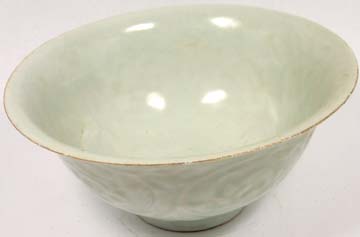
Most of the items I offer come from the collection of a family friend who was active in the field of Archaeology for over forty years. However many of the items also come from purchases I make in Eastern Europe, India, and from the Levant (Eastern Mediterranean/Near East) from various institutions and dealers. Though I have always had an interest in archaeology, my own academic background was in sociology and cultural anthropology. After my retirement however, I found myself drawn to archaeology as well. Aside from my own personal collection, I have made extensive and frequent additions of my own via purchases on Ebay (of course), as well as many purchases from both dealers and institutions throughout the world – but especially in the Near East and in Eastern Europe. I spend over half of my year out of the United States, and have spent much of my life either in India or Eastern Europe. In fact much of what we generate on Yahoo, Amazon and Ebay goes to support The Hermitage Museum in St. Petersburg, as well as some other worthy institutions in Europe connected with Anthropology and Archaeology.
I acquire some small but interesting collections overseas from time-to-time, and have as well some duplicate items within my own collection which I occasionally decide to part with. Though I have a collection of ancient coins numbering in the tens of thousands, my primary interest is in ancient jewelry. My wife also is an active participant in the “business” of antique and ancient jewelry, and is from Russia. I would be happy to provide you with a certificate/guarantee of authenticity for any item you purchase from me. There is a $2 fee for mailing under separate cover. Whenever I am overseas I have made arrangements for purchases to be shipped out via domestic mail. If I am in the field, you may have to wait for a week or two for a COA to arrive via international air mail. But you can be sure your purchase will arrive properly packaged and promptly – even if I am absent. And when I am in a remote field location with merely a notebook computer, at times I am not able to access my email for a day or two, so be patient, I will always respond to every email. Please see our "ADDITIONAL TERMS OF SALE."



















